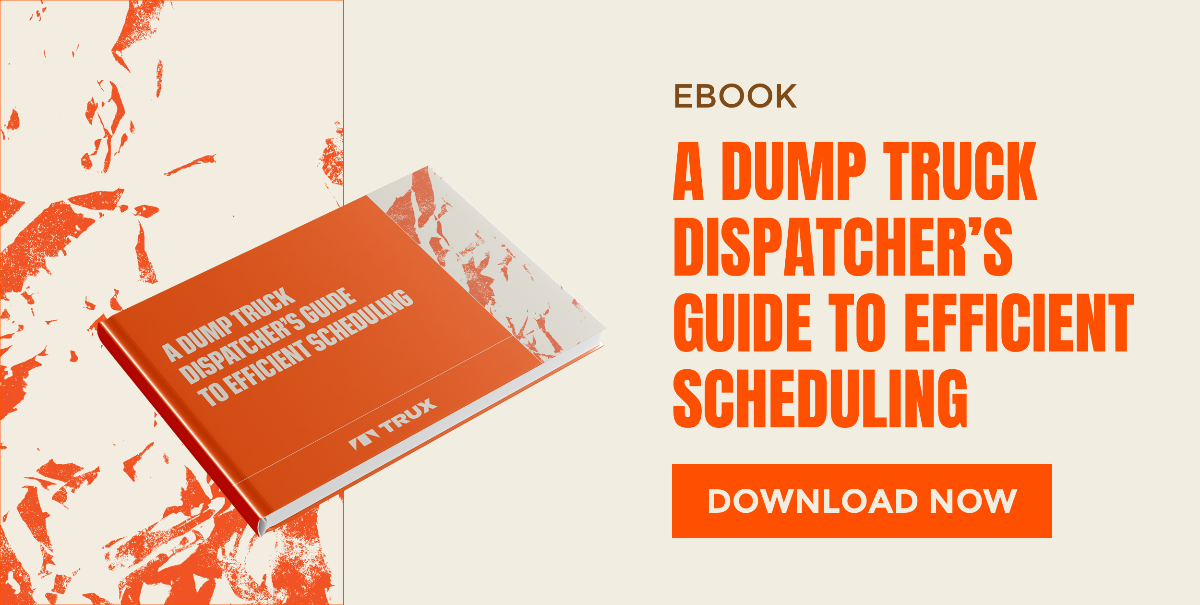9 min read
Leveraging Data Analytics for Better Decision-Making
By: TRUX Team on Nov 22, 2024 9:34:58 AM

In the construction industry, making the right decisions at the right time can mean the difference between a successful project and one plagued by delays and cost overruns. Yet, many professionals in the industry still rely on outdated methods or gut feelings to guide critical decisions. In an era defined by technological advancements, data analytics has emerged as a game-changer, providing the insights needed to navigate complex projects with confidence.
By collecting and analyzing data, construction teams can unlock new levels of efficiency, save money, and allocate resources more effectively. From tracking material deliveries to optimizing fleet usage, data-driven tools transform scattered information into actionable insights. As the industry grows more competitive, the ability to harness these insights isn’t just a luxury—it’s a necessity.
In this blog, we’ll explore how data analytics enhances decision-making across construction projects, tackle the tangible benefits it offers, and highlight how Trux’s powerful analytics capabilities can empower you to streamline operations and drive success.
Click a topic below to jump to the relevant section:
The Role of Data in Construction
Benefits of Data Analytics in Decision-Making
How Trux Empowers Construction Professionals Through Analytics
Real-Life Applications of Data Analytics in Construction
Steps to Implement Data Analytics in Your Operations
Conclusion: Turning Data into Your Competitive Edge
The Role of Data in Construction
Current Challenges Without Data
For years, the construction industry has grappled with inefficiencies stemming from a lack of actionable insights. Many decisions are based on intuition or experience rather than hard evidence, which can lead to costly mistakes. Delayed projects, underutilized equipment, over-budget expenditures, and inconsistent resource allocation are common pain points that stem from an absence of reliable data.
Imagine a job site where materials are late, trucks sit idle, and project managers scramble to adjust schedules. These scenarios are not uncommon, and they highlight the need for data to create order from chaos. Without it, construction teams are left reacting to problems instead of preventing them.
Types of Data Collected in Construction
Data collection in construction spans a wide array of metrics, each offering valuable insights:
- Equipment Usage: Monitor how machinery is utilized to minimize idle time and reduce wear and tear.
- Material Delivery Cycles: Track delivery times and volumes to avoid bottlenecks or material shortages.
- Workforce Productivity: Analyze labor output to identify inefficiencies or opportunities for improvement.
- Environmental Conditions: Consider weather or site conditions that might affect timelines.
- Project Milestones: Ensure tasks are completed on schedule and aligned with project goals.
When these data points are collected and analyzed, they provide a clearer picture of what’s happening on the ground, enabling more strategic planning and execution.
Benefits of Data Analytics in Decision-Making
1. Enhanced Efficiency
Time is one of the most valuable resources in construction, and wasted time translates directly into increased costs. Data analytics allows project managers to optimize workflows, identify bottlenecks, and adjust schedules in real time. By analyzing historical data, teams can also predict potential delays and proactively address them before they derail progress.
For example, tracking the movement of trucks and materials using real-time GPS data can help ensure deliveries align perfectly with project needs. This reduces idle time on job sites and keeps crews productive, improving overall efficiency.
2. Cost Savings
Cost overruns are a common challenge in the construction industry. With data analytics, teams can closely monitor spending, identify areas of waste, and make adjustments to stay within budget. For instance, tracking job-specific costs—such as fuel usage, load deliveries, and labor hours—allows for better financial control and smarter allocation of resources.
Moreover, by leveraging predictive analytics, construction managers can anticipate maintenance needs for equipment, reducing the likelihood of costly downtime or unexpected repairs.
3. Improved Resource Management
Construction projects rely on a careful balance of materials, equipment, and labor. Data analytics provides the insights needed to allocate resources where they’re needed most. By analyzing usage patterns, teams can identify underused assets, avoid overordering materials, and ensure every crew member is working at peak efficiency.
For example, using historical delivery data, project managers can accurately forecast material needs, preventing both shortages and overstocking. This level of precision reduces waste and keeps projects moving smoothly.
How Trux Empowers Construction Professionals Through Analytics
At Trux, we understand that data is more than just numbers—it’s the key to smarter decisions and better outcomes in construction. That’s why our platform is designed to provide construction professionals with the tools they need to harness data effectively and drive results. Here’s how Trux’s analytics capabilities make it happen:
1. Real-Time GPS Tracking
Knowing where your trucks and materials are at any moment is critical to maintaining efficiency on the job site. Trux provides live tracking for all trucks—whether they belong to your fleet or are hired haulers. This real-time visibility eliminates guesswork, helping project managers coordinate deliveries seamlessly and avoid costly delays.
2. Data-Driven Insights for Optimization
Trux goes beyond simple tracking by delivering actionable insights. Our platform analyzes key metrics, such as delivery cycle times, hauler performance, and plant productivity. These insights empower you to pinpoint inefficiencies, streamline operations, and make informed adjustments that save time and money.
3. Simplified Back-Office Management
Say goodbye to the mountains of paperwork that often come with managing haulers and deliveries. Trux automates processes like digital ticketing, invoicing, and payment reconciliation. By keeping all your data in one place, our platform reduces administrative overhead and frees up your team to focus on high-value tasks.
4. Access to the Largest Hauler Marketplace
Construction demand can fluctuate, and finding reliable hauling capacity during peak times can be a challenge. Trux connects you to the largest dump truck marketplace in the U.S., ensuring you have the resources you need, exactly when you need them. Our platform also tracks hauler performance, so you can maintain high standards across your projects.
Trux isn’t just a platform—it’s a partner that helps construction professionals turn data into a competitive advantage. Whether you’re tracking loads, optimizing budgets, or improving communication, Trux provides the tools to make smarter decisions every step of the way.
Real-Life Applications of Data Analytics in Construction
1. Reducing Delivery Delays
Imagine a project falling behind schedule due to delayed material deliveries. With Trux, project managers can use real-time GPS tracking to monitor truck locations and anticipate arrival times. If a delay occurs, adjustments can be made immediately, such as rerouting trucks or scheduling additional deliveries from the marketplace. This proactive approach minimizes downtime and ensures projects stay on track.
2. Controlling Budgets
Keeping costs under control is a constant challenge in construction. Trux’s analytics platform allows users to track expenses in real time—by load, hour, or job. For example, project managers can see how much is being spent on hauling per phase of a project and compare it to the budget. By identifying where money is being wasted, teams can make informed decisions to cut unnecessary expenses and stay on budget.
3. Optimizing Fleet Utilization
Underutilized or overworked trucks can create inefficiencies that drain time and money. Trux helps fleet managers analyze truck usage patterns to balance workloads and eliminate waste. If a truck is sitting idle, it can be reassigned to a different job site. Similarly, the data can help managers identify peak times and prepare accordingly by scheduling additional haulers from the Trux marketplace.
4. Streamlining Communication with Stakeholders
Transparent communication is vital to the success of any construction project. Trux’s delivery tracking tools allow stakeholders, including customers, to view truck locations and receive live updates on material deliveries. This transparency builds trust, reduces the need for constant check-ins, and ensures everyone is on the same page.
5. Boosting Productivity on Job Sites
By analyzing delivery cycle times and plant productivity, Trux users can make targeted improvements to job site operations. For instance, if data shows that trucks are spending too much time waiting at the plant, changes can be made to improve load-out efficiency. Over time, these incremental changes add up to significant gains in overall productivity.
Steps to Implement Data Analytics in Your Operations
Transitioning to a data-driven approach might seem daunting, but with the right steps, it’s simpler than you think. Here’s a practical roadmap to start leveraging data analytics in your construction operations:
1. Start Small and Focus on Key Metrics
You don’t need to overhaul your entire operation at once. Begin by identifying one or two critical areas where data can make the biggest impact. For example, start by tracking truck utilization or delivery cycle times. By focusing on specific metrics, you can see quick wins and build momentum for larger-scale analytics adoption.
2. Invest in the Right Tools
Having the right technology is essential for collecting and analyzing data efficiently. Platforms like Trux are designed to simplify this process by integrating data analytics into your everyday operations. From real-time GPS tracking to automated reporting, Trux provides the tools you need without requiring a steep learning curve or additional hardware.
3. Train Your Team
Technology is only as effective as the people using it. Ensure your team understands how to access and use the analytics features of your platform. Provide training sessions or resources to help them feel confident in making data-driven decisions. With user-friendly solutions like Trux, this process is straightforward and can be implemented quickly.
4. Use Data to Drive Proactive Decisions
Once you have data, put it to work. Use insights to address inefficiencies, allocate resources more effectively, and adjust workflows in real time. For example, if analytics show recurring delays at a specific job site, investigate the cause and implement solutions such as improved scheduling or additional hauler support.
5. Continuously Review and Refine
Data analytics isn’t a one-time effort. Regularly review your data to track progress and uncover new opportunities for improvement. As your operations evolve, so will the metrics that matter most. Stay flexible and adjust your analytics strategy to meet changing project demands.
By taking these steps, you can seamlessly integrate data analytics into your construction projects and begin reaping the rewards—greater efficiency, lower costs, and better outcomes.
Conclusion: Turning Data into Your Competitive Edge
The construction industry is no stranger to challenges—tight budgets, strict deadlines, and the constant need for efficient resource management. In this demanding environment, the ability to make informed, data-driven decisions can set your business apart from the competition.
By embracing data analytics, you gain more than just numbers on a screen—you unlock actionable insights that lead to tangible results. From streamlining operations and cutting costs to improving transparency and resource allocation, data analytics has the power to transform your projects and drive success.
With Trux, leveraging the power of data is easier than ever. Our platform empowers construction professionals to track, analyze, and act on critical information—all from one user-friendly solution. Whether it’s optimizing fleet usage, managing hauler payments, or improving job site efficiency, Trux helps you stay ahead in an industry where every decision counts.
Don’t let outdated processes hold your business back. Take control of your operations with Trux and experience firsthand how data-driven decisions can elevate your projects and profitability. Ready to see what Trux can do for you? Schedule a demo today and start building smarter.
Related Posts
Transportation Management System (TMS) for Construction Companies
First, let’s start with the basics. Transportation Management Systems have been utilized by a...
The Infrastructure Bill and Heavy Civil Construction Projects
Though there has been great bipartisan progress made, we are still weeks away from seeing a final...
The Top 5 Construction Technology Stories of 2019 from TRUX
This year construction technology experienced remarkable growth, including logistics management...

